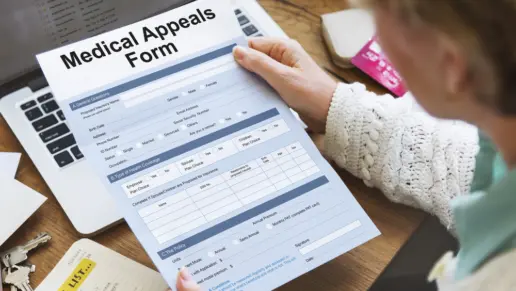Paying for Rehab With Medicare and Medicaid Insurance
Medicare and Medicaid are federal and state-funded health insurance programs that have a number of eligibility requirements applicants must meet, along with offering different levels of coverage for addiction treatment.
Fast Facts
- Medicare and Medicaid may pay part – or all – of the costs of rehab.1
- The eligibility criteria for these programs often change. If you’ve been denied in the past, it’s possible that you may be eligible at a later date.
- If you qualify, Medicaid coverage can supplement Medicare coverage, which helps with the cost of Medicare premiums.12
- Both Medicaid and Medicare make decisions about non-disability-related eligibility within 45 days of coverage application.2
Medicare Coverage for Addiction Treatment
Medicare is a national insurance plan managed by the federal government. Unlike private health insurance, Medicare doesn’t offer coverage plans for families or couples.
Medicare pays for treatment of substance use disorders in both inpatient and outpatient settings:2,8,9
- Medicare Part A pays for inpatient substance abuse treatment; individuals will pay the same co-pays as for any other type of inpatient hospitalization.
- Medicare Part B pays for outpatient addiction treatment services obtained from a clinic or hospital.
While Medicare covers a variety of mental health and substance abuse disorders, there are special rules that limit the amount of coverage provided for those services.
Other covered benefits and services for the treatment of substance use disorders include:3
- Psychotherapy
- Patient education regarding diagnosis and treatment
- Post-hospitalization follow-up
- Outpatient prescription drugs though Medicare Part D
- Inpatient prescription drugs including methadone
Types of Medicare Health Insurance Available
Individuals are able to select one of the following:
- Original Medicare: This plan is made up of hospital insurance (Part A) and medical insurance (Part B). When you receive a covered service or treatment, Medicare pays their part, and you are responsible for paying the rest. You’re able to see any provider at any facility or clinic, so long as they accept Medicare. If you want prescription medication coverage, you’ll have to add a Medicare drug plan (Part D).12
- Medicare Advantage Plan: Since this is a Medicare-approved health plan, you’re able to choose the private insurance company that provides your health and drug coverage. In most cases, your doctors and care providers need to be in-network in order to be covered by the plan. Many of these plans also offer coverage for prescription medications, vision, hearing, dental, even gym memberships. With a Medicare Advantage Plan, you can choose the type of plan you want, including:3
- PPO
- HMO
- Private Fee-for-Service Plans (PFFS)
- Special Needs Plan (SNP) options
- Medicare PPO plans provide you with a network of healthcare providers, doctors, clinics, and hospitals. You can obtain covered services and treatments from out-of-network specialists, but those will typically be additional cost for you. Emergency and urgent care services are always covered.3
- Medicare HMO plans allow you to obtain services only from in-network providers and facilities. The only exceptions are for emergency care, out-of-network urgent care, and out-of-area dialysis. Some HMO plans offer prescription drug coverage, but you should confirm that coverage exists first. If your chosen HMO plan doesn’t offer prescription drug coverage, you won’t be able to join a separate Medicare drug plan.5
- Medicare PFFS plans are offered by private insurance companies, and they determine how much is paid for health care services, doctors, providers, and hospitals. These same private insurance companies also decide how much you pay for care.4
- Medicare SNP membership is only for individuals with specific diseases or conditions. To qualify, you must have Medicate Part A (hospital insurance), Part B (medical insurance), live in an area that the SNP plan services, and be diagnosed with a severe condition like chronic alcoholism or other severe drug dependence.6
Medicare Eligibility for Treatment
You may be eligible for Medicare if:11
- You are age 65 or older.
- You are younger than 65 and have a disability.
- You are younger than 65 and have end-stage renal disease or ALS (Lou Gehrig’s disease).
If you have a limited income, you may qualify for a Medicaid insurance plan, which can be used to supplement your Medicare coverage. This is a type of dual coverage that can help you pay Medicare premiums.7
Medicaid Health Insurance Coverage for Addiction Treatment
Medicaid is a health insurance plan that’s funded by state and federal government. It is managed by individual states, but each state has to abide by federal guidelines.15
Medicaid offers affordable health insurance to eligible low-income adults, children, pregnant women, older people, and those with certain disabilities. It covers addiction treatment services, but the level of coverage and the copayment amounts will vary from state to state.15.16 Medicaid allows for a continuum of care with addiction treatment and can connect you with social services that meet your recovery needs.
Who is Eligible for Medicaid?
Low-income families, qualified pregnant women and children, and people who receive Supplemental Security Income (SSI) are some of the groups that qualify for mandatory eligibility.20
What is Dual Eligibility Health Insurance?
A person may be enrolled in both Medicaid and Medicare at the same time if they meet the eligibility requirements for both. Someone who has both types of coverage is known to be a dual-eligible beneficiary.13,19
Medicare typically pays for Medicare-covered services first, then Medicaid comes in and covers the services Medicare does not.19
Medicaid Income Brackets
Each state has a wide variety of eligibility requirements, but they must still abide by federal guidelines. Eligibility is primarily driven by the federal poverty levels of each state.
Below is a table of federal poverty guidelines for states in the contiguous United States and the District of Columbia as of 2023:14
Family Size |
Household Poverty Guideline |
|
Individuals |
$14,580 |
|
Family of 2 |
$19,720 |
|
Family of 3 |
$24,860 |
|
Family of 4 |
$30,000 |
|
Family of 5 |
$35,140 |
|
Family of 6 |
$40,280 |
Medicaid By State and Alternative Program Names
In states that used the Affordable Care Act to expand Medicaid, people who earn 138% above poverty level can now qualify for Medicaid. However, income limits are much lower in states that didn’t expand Medicaid benefits.17,18
States often refer to their Medicaid programs using alternative names. In addition to the list of alternative program names found in the table below, some states refer to their Medicaid program as their State Plan or as Title XIX.
In order to apply for coverage or obtain information about a state plan, you’ll need to know the exact name of your state’s Medicaid program.18
You’ll find a list of alternate names in the table below:21
State |
Alternative Name |
| Alabama | — |
| Alaska | DenaliCare |
| Arizona | Arizona Health Care Cost Containment System (AHCCCS) |
| Arkansas | — |
| California | Medi-Cal |
| Colorado | Health First Colorado |
| Connecticut | HuskyHealth |
| Delaware | Diamond State Health Plan (Plus) |
| Florida | Statewide Medicaid Managed Care Program |
| Georgia | — |
| Hawaii | MedQuest |
| Idaho | — |
| Illinois | Medical Assistance Program |
| Indiana | Hoosier Healthwise Hoosier Care Connect M.E.D. Works Health Indiana Plan (HIP) |
| Iowa | IA Health Link |
| Kansas | KanCare Medical Assistance Program |
| Kentucky | — |
| Louisiana | Bayou Health HealthyLouisiana |
| Maine | MaineCare |
| Maryland | Medical Assistance |
| Massachusetts | MassHealth |
| Michigan | Medical Assistance or MA |
| Minnesota | Medical Assistance (MA) / MinnesotaCare |
| Mississippi | Mississippi Coordinated Access Network (MississippiCAN) |
| Missouri | MO HealthNet |
| Montana | — |
| Nebraska | ACCESSNebraska |
| Nevada | — |
| New Hampshire | — |
| New Jersey | New Jersey FamilyCare |
| New Mexico | Centennial Care |
| New York | Medicaid Managed Care |
| North Carolina | Division of Medical Assistance (DMA) |
| North Dakota | North Dakota Medicaid Expansion Program |
| Ohio | — |
| Oklahoma | SoonerCare |
| Oregon | Oregon Health Plan |
| Pennsylvania | Medical Assistance (MA) |
| Rhode Island | RI Medical Assistance Program |
| South Carolina | Healthy Connections |
| South Dakota | — |
| Tennessee | TennCare |
| Texas | — |
| Utah | — |
| Vermont | Green Mountain Care |
| Virginia | — |
| Washington | Apple Health |
| Washington D.C. | Healthy Families |
| West Virginia | — |
| Wisconsin | ForwardHealth / BadgerCare |
| Wyoming | EqualityCare |
Resources
- Mental health & substance use disorder services. (n.d.). Medicare. From https://www.medicare.gov/coverage/mental-health-substance-use-disorder-services
- Parts of medicare. (n.d.). Medicare. Retrieved May 27, 2023, From https://www.medicare.gov/basics/get-started-with-medicare/medicare-basics/parts-of-medicare
- Medicare.gov. (n.d.). From https://www.medicare.gov/types-of-medicare-health-plans/medicare-advantage-plans
- Medicare.gov. (n.d.). From https://www.medicare.gov/types-of-medicare-health-plans/preferred-provider-organization-ppo
- Medicare.gov. (n.d.). From https://www.medicare.gov/types-of-medicare-health-plans/medicare-advantage-plans/health-maintenance-organization-hmo
- Special needs plans (SNP). (n.d.). Medicare. From https://www.medicare.gov/health-drug-plans/health-plans/your-coverage-options/SNP
- Medicaid. (n.d.). Medicare. From https://www.medicare.gov/basics/costs/help/medicaid
- Inpatient hospital care coverage. (n.d.). From https://www.medicare.gov/coverage/inpatient-hospital-care
- Alcohol misuse screening coverage. (n.d.). From https://www.medicare.gov/coverage/alcohol-misuse-screenings-counseling
- Medicare.gov. Opioid Use Disorder Treatment Services.
- Centers for Medicare & Medicaid Services. Medicare & Your Mental Health Benefits.
- Medicare.gov. What Medicare Part D Drug Plans Cover.
- Centers for Medicare & Medicaid Services. (2020). People Dually Eligible for Medicare and Medicaid.
- Federal poverty level (FPL) – Glossary. (n.d.). HealthCare.Gov. From https://www.healthcare.gov/glossary/federal-poverty-level-fpl/
- Medicaid. (2021). Medicaid. https://www.medicaid.gov/medicaid/index.html.
- Medicaid.gov. (2021). Substance Use Disorders.
- Medicaid.gov. (n.d.). Parity.
- National Conference of State Legislatures. (2011). Medicaid and the Affordable Care Act.
- Medicaid and CHIP Payment and Access Commission. (n.d.). How Medicaid Interacts with Other Payers.
- Medicaid.gov. (n.d.). Eligibility.
- Assistant Secretary for Planning and Evaluation (ASPE). (2021). U.S. Federal Poverty Guidelines to Determine Eligibility for Federal Programs.




